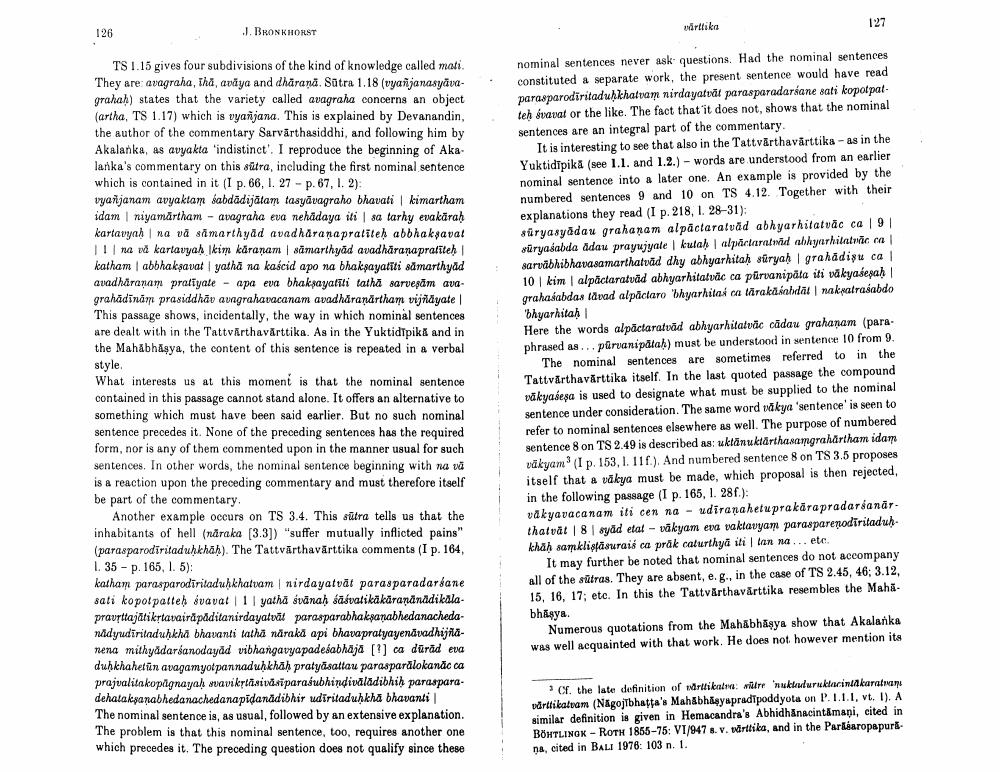________________
126
J. BRONKHORST
TS 1.15 gives four subdivisions of the kind of knowledge called mati. They are avagraha, tha, avaya and dharaṇā. Sūtra 1.18 (vyanjanasyāvagrahaḥ) states that the variety called avagraha concerns an object (artha, TS 1.17) which is vyanjana. This is explained by Devanandin, the author of the commentary Sarvarthasiddhi, and following him by Akalanka, as avyakta 'indistinct'. I reproduce the beginning of Akalanka's commentary on this sutra, including the first nominal sentence which is contained in it (I p. 66, 1. 27 - p. 67, 1. 2):
vyañjanam avyaktam sabdādijātam tasyavagraho bhavati | kimartham idam | niyamartham - avagraha eva nehädaya iti | sa tarhy evakāraḥ kartavyaḥ na va samarthyad avadharaṇapratiteḥ abbhaksavat |1|na va kartavyaḥ kim karanam | samarthyad avadhāraṇapratiteḥ | katham | abbhakṣavat | yatha na kaścid apo na bhakṣayatiti sămarthyad avadharanam pratiyale apa eva bhakṣayatīti tatha sarveṣām avagrahādīnām prasiddhav avagrahavacanam avadhāraṇārtham vijñāyate | This passage shows, incidentally, the way in which nominal sentences are dealt with in the Tattvärthavarttika. As in the Yuktidipika and in the Mahabhaṣya, the content of this sentence is repeated in a verbal style.
What interests us at this moment is that the nominal sentence contained in this passage cannot stand alone. It offers an alternative to something which must have been said earlier. But no such nominal sentence precedes it. None of the preceding sentences has the required form, nor is any of them commented upon in the manner usual for such sentences. In other words, the nominal sentence beginning with na va is a reaction upon the preceding commentary and must therefore itself be part of the commentary.
Another example occurs on TS 3.4. This sutra tells us that the inhabitants of hell (näraka [3.3]) "suffer mutually inflicted pains" (parasparodiritaduḥkhaḥ). The Tattvärthavarttika comments (I p. 164, 1. 35 p. 165, 1. 5):
katham parasparodiritaduḥkhatvam nirdayatvat parasparadarsane sati kopotpatteḥ svavat | 1 | yatha śvānaḥ śāśvatikākāraṇānādikālapravṛttajatikṛtavairäpäditanirdayatvät parasparabhakṣaṇabhedanachedanadyudiritaduḥkha bhavanti tatha näraka api bhavapratyayenāvadhijñānena mithyadarsanodayad vibhangavyapadeśabhäjä [?] ca düräd eva duḥkhahetun avagamyotpannaduḥkhäḥ pratyasattau parasparǎlokanāc ca prajvalitakopagnayaḥ svavikṛtāsiväsiparašubhinḍivālādibhiḥ parasparadehalaksanabhedanachedanapiḍanadibhir udiritaduḥkha bhavanti
The nominal sentence is, as usual, followed by an extensive explanation. The problem is that this nominal sentence, too, requires another one which precedes it. The preceding question does not qualify since these
värttika
127
nominal sentences never ask questions. Had the nominal sentences constituted a separate work, the present sentence would have read. parasparodiritaduḥkhatvam nirdayatvat parasparadarsane sati kopotpat teh svavat or the like. The fact that it does not, shows that the nominal sentences are an integral part of the commentary.
It is interesting to see that also in the Tattvärthavärttika - as in the Yuktidīpikā (see 1.1. and 1.2.) words are understood from an earlier nominal sentence into a later one. An example is provided by the numbered sentences 9 and 10 on TS 4.12. Together with their explanations they read (I p. 218, 1. 28-31):
suryasyadau grahanam alpactaratvad abhyarhitatvac ca | 9| suryasabda adau prayujyate | kutaḥ | alpactaratwad abhyarhitatrac ca | sarvabhibhavasamarthatvad dhy abhyarhitaḥ suryaḥ | grahadisu ca | 10 kim | alpactaratvad abhyarhitatvac ca purvanipäta iti vakyaseṣaḥ | grahasabdas tavad alpactaro 'bhyarhitaś ca tarakāśabdāt | nakṣatrasabdo 'bhyarhitaḥ |
Here the words alpactaratvad abhyarhitatvac cadau grahanam (paraphrased as... pūrvanipataḥ) must be understood in sentence 10 from 9.
The nominal sentences are sometimes referred to in the Tattvärthavärttika itself. In the last quoted passage the compound vakyaseṣa is used to designate what must be supplied to the nominal sentence under consideration. The same word vakya 'sentence' is seen to refer to nominal sentences elsewhere as well. The purpose of numbered sentence 8 on TS 2.49 is described as: uktänuktärthasamgrahartham idam väkyam (I p. 153, 1. 11f.). And numbered sentence 8 on TS 3.5 proposes itself that a vakya must be made, which proposal is then rejected, in the following passage (I p. 165, 1. 28f.): vakyavacanam iti cen na - udiraṇahetuprakarapradarśanarthatvat | 8| syad etat - vakyam eva vaktavyam parasparenodiritaduḥkhäḥ samklistãsurais ca prak caturthya iti | tan na... etc.
It may further be noted that nominal sentences do not accompany all of the sutras. They are absent, e. g., in the case of TS 2.45, 46; 3.12, 15, 16, 17; etc. In this the Tattvärthavärttika resembles the Mahabhāṣya.
Numerous quotations from the Mahabhaṣya show that Akalanka was well acquainted with that work. He does not however mention its
Cf. the late definition of väritikatva: wütre nuktaduruktacintākaratvanı värttikatvam (Nagojibhatta's Mahabhayapradipoddyota on P.1.1.1, vt. 1). A similar definition is given in Hemacandra's Abhidhanacintämaņi, cited in BÖHTLINGKROTH 1855-75: VI/947 s. v. värttika, and in the Parléaropapurăna, cited in BALI 1976: 103 n. 1.




